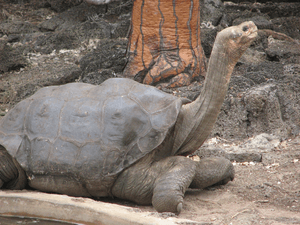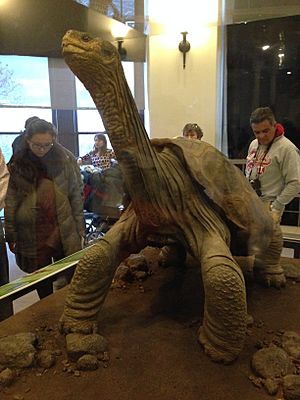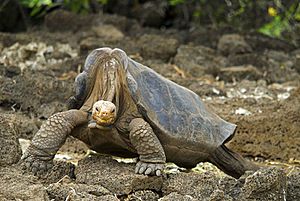Lonesome George facts for kids

Lonesome George at Galápagos National Park headquarters in 2006
|
|
| Species | Chelonoidis niger abingdonii (Pinta Island tortoise) |
|---|---|
| Sex | Male |
| Hatched | c. 1910 |
| Died | June 24, 2012 (aged 101–102) Galápagos National Park |
| Resting place | Taxidermied and on display at Galápagos National Park |
| Nation from | Ecuador (Galápagos) |
| Known for | Being an endling |
| Offspring | None |
| Named after | possibly George Gobel |
Lonesome George (Spanish: Solitario George or Jorge, c. 1910 – June 24, 2012) was a male Pinta Island tortoise. He was the last known individual of his kind. In his final years, many called him the rarest creature in the world. George became a very important symbol for protecting animals and nature. This was true in the Galápagos Islands and all over the world.
Contents
Discovery of Lonesome George
George was first found on the island of Pinta on November 1, 1971. A scientist from Hungary named József Vágvölgyi discovered him. The plants on Pinta Island had been badly damaged by wild goats that people brought there. Because of this, almost all the Pinta Island tortoises had disappeared. George was the only one left.
People think he was named after an American actor, George Gobel. To keep him safe, George was moved to the Charles Darwin Research Station. This station is on Santa Cruz Island. He lived there for the rest of his life. A man named Fausto Llerena took care of him for many years. The tortoise breeding center there is now named after Fausto.
Scientists hoped to find more Pinta Island tortoises. They looked on Pinta Island and in zoos around the world. But no other Pinta Island tortoises were ever found. Because George was the last one and couldn't have babies, his kind was declared functionally extinct.
Mating Attempts and Reproduction
For many years, scientists tried to help Lonesome George have babies. All these attempts were unsuccessful. The researchers at the Darwin Station even offered a $10,000 reward. They hoped someone would find a female tortoise that could be his mate.
Until January 2011, George lived with two female tortoises. These females were from the Wolf Volcano area of Isabela Island. They were a different type of giant tortoise. Scientists hoped that George's unique genetic information would be passed on to any babies. However, any offspring would have been a mix of two different types of tortoises. They would not have been pure Pinta Island tortoises.
In July 2008, George mated with one of his female companions. They collected 13 eggs and put them in special incubators. In November 2008, scientists reported that most of the eggs were not developing. By December, none of the eggs had hatched. X-rays showed they were not able to grow.
On July 23, 2009, one year after the first mating news, the Galápagos National Park announced more good news. One of George's female companions had laid a second group of five eggs. The park was very hopeful because the eggs looked perfect. These eggs were also moved to an incubator. But on December 16, it was announced that these eggs also failed to hatch. A third group of six eggs from the other female also did not hatch.
In November 1999, scientists found that Lonesome George was closely related to tortoises from Española Island and San Cristóbal Island. So, in January 2011, two female tortoises from Española Island were brought to the Charles Darwin Research Station. George lived with them, hoping for better luck.
Death of Lonesome George

On June 24, 2012, at 8:00 A.M., Lonesome George was found dead. Fausto Llerana, who had cared for him for 40 years, found him. The director of Galápagos National Park, Edwin Naula, thought George died because his heart stopped. An examination after his death confirmed he died of natural causes.
George's body was frozen and sent to the American Museum of Natural History in New York City. There, experts preserved him using taxidermy. This means his body was prepared and stuffed to look alive. A taxidermist named George Dante did the work, with help from scientists.
After being shown for a short time at the museum, Lonesome George's preserved body was expected to return to the Galápagos. The plan was to display him at the Galapagos National Park headquarters. However, a disagreement happened between the government of Ecuador and the Galápagos Islands. The Ecuadorean government wanted to show him in the capital city, Quito. But the local mayor of the Galápagos said George was a symbol of the islands and should come home.
On February 17, 2017, Lonesome George's preserved body was flown back to the Galápagos Islands. He is now on display in a special building. This building is completely dedicated to him. It is called the Fausto Llerena Breeding Center. It is located at the Galapagos National Park headquarters on Santa Cruz. Most people say Lonesome George was over 100 years old when he died. However, some, like David Attenborough, thought he might have been in his 80s or even younger. Even at 100, he was not especially old for a Galápagos tortoise.
The TV show Futurama dedicated an episode called "Naturama" to his memory.
Hope for the Species: Biological Conservation
In November 2012, scientists shared some exciting news. They found 17 tortoises that were partly related to Lonesome George's species. This made them think that some purebred tortoises of his kind might still be alive.
In December 2015, another discovery was made. Researchers from Yale found a new type of tortoise. Its D.N.A. was 90% similar to the Pinta Island tortoise. Scientists believe this discovery could help bring Lonesome George's species back. This means he might not be the very last of his kind after all.
In December 2018, a study looked at George's genetic code, called his genome. They also studied genes related to aging. They found that the population of his species had been shrinking for about a million years. They also learned about how giant tortoises live so long and fight off sickness.
See also
 In Spanish: Solitario George para niños
In Spanish: Solitario George para niños
- Jonathan (tortoise)
- The Life Cairn
- Mr Turpen



